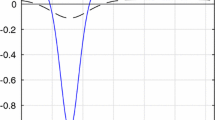Abstract
An alternative to Packlington’s and Harrington’s integral equations method of numerically solving a boundary electrodynamics problem for curvilinear perfectly conducing surfaces is suggested. The essence of this method consists in a joint solution of integral equations system with respect to the unknown complex vectors of current and charge density, the use of parametric mapping technique to represent the curvilinear surface, Galerkin’s method with boundary elements, “points sewing” method for Lorentz calibration. On an example of calculating the current distribution on a bicubic surface the advantages of the suggested method are demonstrated in comparison to Packlington’s and Harrington’s integral equations.
Similar content being viewed by others
References
R. Mittra, Computer Techniques for Electromagnetics (Pergamon Press, Oxford-New York-Toronto-Sydney-Braunschweig, 1973; Mir, Moscow, 1977).
Lee K, Basics of CAD/CAM/CAE (Piter, St. Petersburg, 2004) [in Russian].
J. À. Stratton, Electromagnetic Theory (MGH, N.Y.-London, 1941; GITTL, Moscow, 1948).
I. Ya. Bakelman, Advanced Geometry, Handbook for pedagogical institutes (Prosveshchenie, Moscow, 1967) [in Rusian].
À. F. Bermant, Mapping. Curvilinear Coordinates. Transformations. Green Formulas (GITTL, Moscow, 1958) [in Russian].
À. I. Borisenko and I. Ye. Tarapov, Vector Analysis and Basics of Tensor Mathematics (Vyssh. Shkola, Kharkov, 1978) [in Russian].
G. T. Markov, B. Ì. Petrov, and G. P. Grudinskaya, Electrodynamics and Wave Propagation, Handbook for HEI (Sov. Radio, Moscow, 1979) [in Russian].
K. À. Krug, Basics of Electronics, Vol. 1 (Gosenergoizdat, Moscow, 1946) [in Russian].
J. L. Volakis, A. Chatterjee, and L. C. Kampel, Finite Element Method for Electromagnetics: with Applications to Antennas, Microwave Circuits, and Scattering (IEEE Press, New York, 1998).
A. W. Glisson and D. R. Wilton, “Simple and efficient numerical methods for problems of electromagnetic radiation and scattering from surfaces,” IEEE Trans. Antennas Propag. 28,No. 5, 593 (September 1980).
G. Ò. Markov, Antennas (Gosenergoizdat, Moscow, 1960) [in Russian].
Author information
Authors and Affiliations
Additional information
Original Russian Text © F.F. Dubrovka, A.V. Tolkachev, 2009, published in Izv. Vyssh. Uchebn. Zaved., Radioelektron., 2009, Vol. 52, No. 11, pp. 3–30.
About this article
Cite this article
Dubrovka, F.F., Tolkachev, A.V. An effective method of numerical solution of a boundary electrodynamics problem for arbitrary conducting surfaces. Radioelectron.Commun.Syst. 52, 573–590 (2009). https://doi.org/10.3103/S0735272709110016
Accepted:
Published:
Issue Date:
DOI: https://doi.org/10.3103/S0735272709110016



